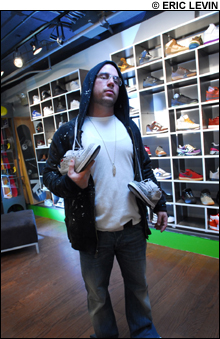To the brands, the hardcore collectors are commercial visionaries. “Before, a lot of this stuff just stayed in this culture,” says Steve Gardner, vice-president of Lifestyle at Reebok. “[Now] a lot of these kids are influencing fashion — they’ve become the trend leaders.”
Give me two pairs
Sneaker love didn’t start with that first resplendent pair of high-topped, wing-logoed Air Jordans in 1985. But the Mercedes-Benz of balling shoes certainly shifted kick-worship into higher gear. Soon after, Run DMC did the illest things with their shell-toed Adidas, followed by Do the Right Thing’s Buggin’ Out getting in a white man’s face for stepping on his “brand-new white” Air Jordans and some well-publicized real-life shoe-related beatdowns.

Two decades, lyrical name-drops from the likes of Foxy Brown, the Game, and Scarface, and one Nelly song about Air Force 1s later, sneakerheads run different games. Many collectors are unabashed Nike worshippers — obsessed with the Oregon behemoth’s practice of putting out limited-edition shoes every month. Some are slaves to Bathing Apes (a/k/a BAPEs), a trendy Japanese clothing and sneaker label of vibrantly colored kicks that usually retail in the United States for around $200. Some want sneakers that drop with huge hype, like last July’s Nike Diamond Dunk SBs, a/k/a the Tiffany Dunks, a powder-blue and burnished-silver pair that sold out of Concepts, the Harvard Square sneaker shop hidden in the back of the Tannery, in 10 minutes. Some buyers are in it for the extra income, queuing up outside stores for short runs and reselling their spoils to the highest bidder like old-school ticket scalpers. Some won’t buy Nike because they’re too corporate. Some just amass Jordans, long regarded as the Benzes of basketball shoes. Or kicks with orange colorways. Or the strange-footwear rejects found in retail outlets. Or the hard-core nucleus of sneaker collectors devour: limited editions.
Deon Point loves the braggadocio of it all. “There’s like a few different crews [of sneakerheads],” says the 27-year-old Concepts employee, who raps with Cambridge hip-hop trio the Skitzofreniks and says that most ’heads exaggerate their collection. “My people, the ones that I chill with, it’s more for just to be fly, just be to an asshole and say, ‘Yeah, we got this and you don’t.’” But Point doesn’t show what he’s got unless he owns double or triple sets. “I’m sure you had an article of clothing you were really in love with. Once you lose that and you can’t get it back, it’s a horrible feeling. In order to compensate for that, I get doubles.”
DeJongh “Dee” Wells says he’s always fostered “a passion for sole,” but also sees sneakers as an investment. The 32-year-old advertising arm of the bimonthly glossy Sole Collector, Wells stopped tallying his collection after 550 pairs. (The industry often looks to sneakerheads for employees, consultants, and testers — Wells says he got his job because he made a name for himself on a sneaker message board.) His best treasures are old-school: a vintage pair of Puma Clyde baskets, 1978 waffle-treaded Nike Cortez, and an original 1989 set of Air Jordan IVs. He guesstimates the latter to be worth $800. “I can’t wear the sneaker because it’s so old it’d just disintegrate.”
Married with a five-year-old daughter, Wells thinks he’ll be able to fund his little girl’s education by reselling his deadstock. So he keeps his shoes secure, divided among a U-Haul storage facility, his Worcester home, and relatives in Brooklyn, St. John, St. Thomas, and Puerto Rico. “I can’t keep them in one place because if something happens, I’ll be shit out of luck,” Wells explains. “God forbid, there’s a fire or someone decides to break into my house. Crazy, right?”
Mike Chung, a/k/a Kookies, belongs to a sneakerhead strain that doesn’t brag about his collection. “I like to be known as someone who knows a lot about sneakers, but not someone who has a lot,” he says, dressed in a Bathing Ape camouflage sweatshirt and green Nike Jedi Dunks. When people ask how many pairs he owns, the 19-year-old Suffolk University sophomore tells them five. In reality, that number is a lot bigger. Sometimes Chung will snatch up products here and resell them over the Web to acquaintances back home in Hong Kong.
 “Sneakers are the only thing available to a man that can make him an individual,” says Jeff Cavalho of Weekly Drop. “The subculture is so small that if I owned a pair of Diamonds, the chance of finding someone else wearing that shoe would be almost nil. But when somebody stops you, which happens occasionally, and they’re like, ‘Where’d you get those?’ There’s a connection.” The right sneaker can be a cipher. “You’re not part of mass culture; you understand something larger about your environment.”
“Sneakers are the only thing available to a man that can make him an individual,” says Jeff Cavalho of Weekly Drop. “The subculture is so small that if I owned a pair of Diamonds, the chance of finding someone else wearing that shoe would be almost nil. But when somebody stops you, which happens occasionally, and they’re like, ‘Where’d you get those?’ There’s a connection.” The right sneaker can be a cipher. “You’re not part of mass culture; you understand something larger about your environment.”